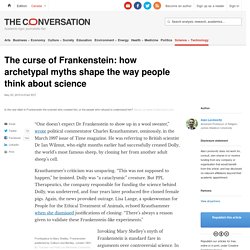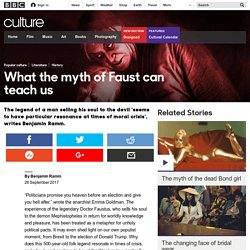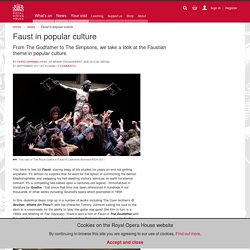

"Manifest Destiny" Educational Rap by MC LaLa. Plato’s Allegory of the Cave - Alex Gendler. 10 Brilliant Retellings of Classical Myths by Female Writers. La Mythologie grecque revisitée... - Le Réveil ... The curse of Frankenstein: how archetypal myths shape the way people think about science. “One doesn’t expect Dr Frankenstein to show up in a wool sweater,” wrote political commentator Charles Krauthammer, ominously, in the March 1997 issue of Time magazine.

He was referring to British scientist Dr Ian Wilmut, who eight months earlier had successfully created Dolly, the world’s most famous sheep, by cloning her from another adult sheep’s cell. Krauthammer’s criticism was unsparing. “This was not supposed to happen,” he insisted. Dolly was “a cataclysmic” creature. But PPL Therapeutics, the company responsible for funding the science behind Dolly, was undeterred, and four years later produced five cloned female pigs. Invoking Mary Shelley’s myth of Frankenstein is standard fare in arguments over controversial science.
Steptoe was wise to dissociate himself from Frankenstein. Indeed, myths appear to lead consistently away from the truth, not toward it. The Frankenstein myth is particularly potent, since it recapitulates elements of the world’s most famous myth. Culture - What the myth of Faust can teach us. “Politicians promise you heaven before an election and give you hell after,” wrote the anarchist Emma Goldman.

The experience of the legendary Doctor Faustus, who sells his soul to the demon Mephistopheles in return for worldly knowledge and pleasure, has been treated as a metaphor for unholy political pacts. It may even shed light on our own populist moment, from Brexit to the election of Donald Trump. Why does this 500-year-old folk legend resonate in times of crisis, and why does it continue to haunt the Western imagination? With the exception of Frankenstein, it is difficult to think of a more enduring modern legend The legend is loosely based on the life of Johann Georg Faust (c 1480–1540), an alchemist and practitioner of necromancy, a form of ‘black magic’. Goethe’s Faust The Faust Legend in History and Modern Culture. Faust in popular culture. You have to feel for Faust; slaving away at his studies for years on end not getting anywhere.

It's almost no surprise that he went for the option of summoning the demon Méphistophélès and swapping his hell-dwelling visitor's services on earth for eternal torment. It's a compelling tale based upon a centuries-old legend - immortalized in literature by Goethe - that since that time has been referenced in hundreds if not thousands of other works including Gounod's opera which premiered in 1859. In film, diabolical deals crop up in a number of works including The Coen brother's O Brother, Where Art Thou? Faustian Bargain: Definition & Overview - Video & Lesson Transcript.
Jewel-encrusted goblet found gathering dust in tiny Spanish museum 'touched the lips of Jesus and is in fact the HOLY GRAIL' say two historians with evidence to prove it. Chalice belonging to Queen Urraca of Spain 'contains Christ's onyx goblet'Has sat on display in basement museum of Basilica of San Isidoro in LeonMargarita Torres and Jose Ortega del Rio say 3-year study proves theory'Was stolen by Egyptian Muslims, gifted to Spain for help during famine' By Mia De Graaf Published: 08:55 EDT, 31 March 2014 | Updated: 12:55 EDT, 31 March 2014 It is a mystery dating back millennia.

But apparently, the long-lost Holy Grail has finally been found - on display in a Spanish museum. The onyx chalice has been sat in the Basilica of San Isidoro in Leon, north Spain, for 1000 years - touted to visitors as a goblet belonging to 11th century Queen Urraca. Holy Grail: Meaning and Facts. The Holy Grail became a popular theme in medieval literature, and stories about it were read and recited throughout Europe.

Some Arthurian tales claimed that Joseph of Arimathea brought the Grail to Glastonbury in England. One legend has it that on the spot where he buried the Grail, the water runs red because it travels through Christ’s blood, though scientists agree this is just the effect of red iron oxide in the soil. Others believed the Knights Templar, a medieval order that protected pilgrims traveling to the Holy Land, seized the Holy Grail from the Temple Mount during the Crusades and secreted it away.
Read exclusive excerpts from the best-selling book, “The Templars: The Rise and Spectacular Fall of God’s Holy Warriors” here The mythical literary figure, King Arthur, was said to coordinate great spiritual expeditions to search for the enigmatic relic. In one popular Arthurian story, a character known as the “Fisher King” had a serious wound that kept him from moving.
Ask History: Is There Really a Holy Grail? The Frankenstein myth. Classics Summarized: Beowulf. Top 10 Notes: Doctor Faustus.